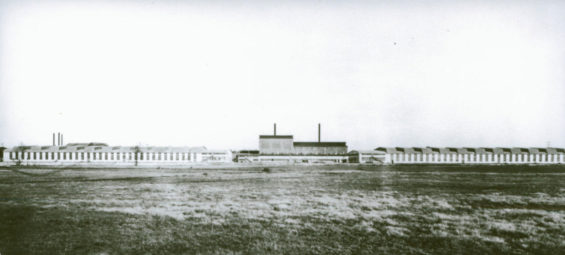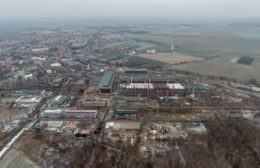Gröditz Subcamp
September 27, 1944 – April 17, 1945
The northernmost subcamp of Flossenbürg, located close to Riesa.
![]()
Machinery-building complex of the Mitteldeutsche Stahlwerke Gröditz, around 1940 (Schmiedewerke Gröditz). The prisoners worked and were quartered in one section of the giant factory hall.
![]()
Aerial view of the factory grounds in Gröditz, 2019 (Flossenbürg Concentration Camp Memorial / Photo: Rainer Viertlböck)
-
Prisoners
A total of almost 1,000 men. 270 each from Poland and Russia, over 120 from France, over 50 each from Germany and Italy, with the others from a further 11 nations
-
In March 1945, about 260 Jewish prisoners from 14 countries arrived, among them 70 from Hungary. The highest number of prisoners was 743 (April 13, 1945).
-
Forced labor and quarters
Construction of anti-aircraft guns for the Mitteldeutsche Stahlwerke (part of the Flick group). The prisoners worked in a separate section of the machine-building area and were quartered on the cramped attic floor.
-
Guards
64 SS men
-
Death toll
At least 220 prisoners died in the camp, many of them as a result of a typhus epidemic, which also claimed the life of detail leader Körmann.
-
Disbanding of the camp / end of the war
The factory managers transported 400 to 500 prisoners who were able to work by truck to Radebeul. From there the prisoners were then forced on a march to Theresienstadt, where they were liberated.
-
186 ill prisoners were shot dead in a sandpit in nearby Koselitz. A work detail of 30 prisoners had to remove all trace of the subcamp and was liberated after a death march by the Red Army in the area of Zinnwald.
-
Commemoration
In Koselitz, a gravesite memorializes the 186 prisoners shot dead. The prisoners who died in Gröditz were buried at various cemeteries after the war. In 2004, a gravesite at the Gröditz Cemetery was inaugurated.

